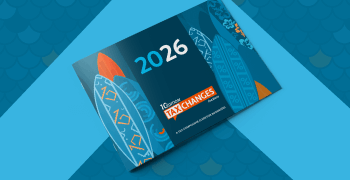
What’s the difference between e-invoicing and real-time reporting?
Many governments worldwide have electronic invoicing (e-invoicing) mandates, and real-time reporting requirements are on the rise. These two terms are often mistakenly treated as synonyms, but while related, they’re not the same. Both can be part of one system — but also implemented independently.
Though there are no e-invoicing or real-time reporting decrees in the United States at this time, they’ll likely hit these shores eventually. In the meantime, U.S. companies often need to navigate e-invoicing and real-time requirements when doing business abroad.
What is electronic invoicing?
Electronic invoicing is a form of electronic billing between a supplier and a buyer. An electronic invoice essentially contains the same information as a paper invoice: purchase order, purchase amount, line items, payment terms, credit notes, etc. It’s just issued, transmitted, and received in an electronic format.
However, an e-invoice is different from a digital invoice (i.e., a PDF or an electronically delivered scan of a paper invoice) because e-invoices are digital files containing structured data designed first and foremost to be automatically exchanged and processed by accounting and ERP systems. They generally take one of two formats, which dictates how the invoice can be sent, viewed, and accepted:
- A structured invoice format for electronic data interchange (EDI) is machine readable but isn’t readable by humans
- A hybrid invoice format combines structured invoice format with a visual format and therefore can be read by both computers and humans
Both of the formats above contain invoice data in a structured format (for example, XML) that can be automatically processed by computers.
By contrast, unstructured digital invoices, such as standard PDFs or Word documents, are only readable by humans; only humans can manually process these. While it’s possible to deploy complex data extraction technologies — sometimes in combination with optical character recognition, or OCR — to identify and extract individual field information from an unstructured digital invoice, this isn’t the same as using a genuine e-invoice. Data extraction technology allows users to limit (though not eliminate) the manual work needed for making an accounts payable entry. Since e-invoices are created in a machine-readable (structured) format from the point of issuance, they can be transmitted into the customer’s ERP system directly, within seconds.
E-invoices aren’t new. For decades, companies worldwide have been implementing efficient e-invoicing systems to automate processes in their finance departments and save cost.
More recently, a growing number of governments have started mandating the use of e-invoicing for companies conducting business within their borders. This trend will likely continue, for reasons we’ll explain later in this article. Countries that are mandating e-invoicing in the next couple of years include France, Spain, and Poland.
There’s no global standard for e-invoicing at this time. In general, all e-invoicing mandates require certain businesses to electronically transmit invoice information to other businesses — and to tax authorities in parallel, in certain instances. However, technical implementation, required formats, and other factors vary by country and are subject to change. Learn more about the ins and outs of e-invoicing in What U.S. sellers need to know about e-invoicing.
What is real-time reporting?
Real-time reporting or live reporting is when a vendor must electronically transmit value-added tax (VAT) data directly to tax authorities in real time or near real time. As with e-invoicing mandates, there’s no real global standard, although standardized formats such as the Standard Audit File for Tax (SAF-T) were introduced years ago.
In contrast to “delayed” periodical VAT reports, receiving VAT information in real time allows tax authorities to better estimate VAT income, detect discrepancies and fraud early, and track performance and trends in the economy. A real-time reporting requirement may be linked to an e-invoicing mandate but can also exist on its own.
While many businesses opt to implement e-invoicing systems voluntarily to streamline business processes, real-time reporting is typically adopted only as a result of a government mandate.
Bringing benefits of e-invoicing and real-time reporting together
Since the invoice is the major source of information for business activities and VAT, real-time reporting is a natural extension of e-invoicing. In fact, where the use of e-invoicing is widespread or mandated, it’s typically only a matter of time before real-time reporting requirements are implemented, as we explain below.
Many countries around the world, including most Latin American countries and several European countries, have combined e-invoicing and real-time VAT reporting requirements into one mandate. While the technical implementations may vary from country to country, the principle is similar: The invoice must be submitted to the tax authority first and can be forwarded to the buyer only after the tax authority approves (clears) the invoice.
Combining e-invoicing with real-time reporting streamlines the exchange of invoice data between business partners and enables tax authorities to retrieve relevant VAT information in real time.
No one size fits all
As noted above, no uniform system governs e-invoicing and real-time reporting requirements across countries. Individual mandates are tailored to suit the needs of each government. Therefore, U.S. businesses conducting trade in these countries must be aware of the individual regulations.
In Spain, for example, businesses with more €6 million in annual revenue must report transactional data to the Spanish Tax Agency (AEAT) within four days after issuing or receiving an invoice. Similar requirements are in effect for certain other taxpayers. Tax officials don’t need to approve the invoice in order for it to be paid, but they get eyes on it and can see whether VAT was properly applied.
Hungary requires taxpayers to automatically submit sales invoice data to the Hungarian National Tax and Customs Administration (NAV) direct from the system issuing the invoice. This mandate applies to numerous business-to-business (B2B) transactions, some business-to-customer (B2C) transactions, exempt domestic supplies, and exports.
All resident businesses registered for VAT in Italy must submit live invoices for B2B transactions, domestic B2C transactions, and business-to-government (B2G) transactions to the Italian Revenue Agency’s e-invoicing platform (Sistema di Interscambio, or SdI), which functions as an invoice approval portal. The invoice won’t be exchanged until the government approves the invoice and provides a digital signature. Italy is planning to implement similar mandates for cross-border sales too. It has some of the most stringent reporting requirements in the world, along with Brazil, Chile, and Mexico.
Countries with e-invoicing mandates typically phase them in, starting with B2G or B2B transactions before adding B2C transactions, as Hungary did. Similarly, most start with transactions occurring within the borders before broadening these requirements to cross-border sales, as Italy is doing. To give taxpayers time to prepare infrastructure and processes, most governments don’t implement e-invoicing and real-time reporting mandates simultaneously.
However, governments worldwide are increasingly implementing real-time reporting mandates within e-invoicing mandates. Avalara’s global tracker provides country-by-country information for new and proposed e-invoicing and real-time reporting requirements.
Why mandate e-invoicing and real-time reporting?
E-invoicing and real-time reporting requirements were developed primarily to help tax authorities plug the VAT gap — the difference between expected VAT revenue and the amount of VAT actually collected. The European Commission attributes the VAT gap to “tax fraud, tax evasion, tax avoidance and optimisation practices, bankruptcies, financial insolvencies, as well as miscalculations and administrative errors.”
European Union member states had a collective VAT gap of more than €134 billion in 2019 and lost approximately €4,000 in VAT revenue every second. Recent estimates gauged the VAT gap to be 20–30% of public revenue globally.
Tax authorities simply cannot effectively detect and eliminate this scale of fraudulent activity or oversight when chasing a paper trail. Electronic invoicing mandates give tax authorities greater visibility into taxpayers’ transactions. Real-time or near-real-time reporting requirements allow officials to use advanced technology such as artificial intelligence to run automated checks and detect anomalies, nipping tax errors and evasion in the bud. Taxpayers can’t fudge their tax returns when tax officials have records of all their invoices.
It’s widely believed to be working. Mandating e-invoicing and real-time reporting have enabled Brazil to increase VAT collections by some $58 billion. Chile and Mexico have cut their tax gaps by about 50%. The visible and measurable success of mandatory e-invoicing and real-time reporting has inspired many governments to institute similar requirements: One new mandate is issued almost every week.
Will the U.S. institute e-invoicing or real-time reporting mandates?
Due to the nature of sales tax, the U.S. doesn’t suffer the same tax gap as many other countries.
Certainly, some sales tax is collected then not remitted, either by oversight or fraud. In fact, numerous states have outlawed the use of sales tax suppression software to help prevent the deliberate withholding of collected sales tax, and New York may soon do the same. But a bigger problem is that some businesses don’t understand the concept of nexus — the connection that allows a tax jurisdiction to tax a business — and therefore don’t know they have an obligation to register for sales tax in the first place.
Nonetheless, there are efforts to digitize tax compliance and invoice processes in the U.S. The Federal Reserve and the Business Payments Coalition (BPC) are in the final stretch of a pilot project that strives to modernize B2B payments through the development of a standardized electronic invoicing system. An operational B2B invoice system could be up and running by 2023.
But of course, sales tax is the purview of individual states, and states may not be ready for real-time compliance.
Still, it’s likely only a matter of time. California and Florida have already considered some type of real-time financial reporting requirements, and Massachusetts Governor Charlie Baker included a real-time sales tax remittance requirement in his 2022 budget proposal, though similar proposals in the past failed to make it to law. The Urban-Brookings Tax Policy Center reports that states are hungry for more taxpayer and transactional data. E-invoicing and real-time reporting mandates would provide it.
How e-invoicing can benefit businesses
Moving from paper or digital invoices to electronic invoices can benefit your business, even if you don’t sell into any country with an e-invoicing or real-time reporting mandate. It streamlines the exchange of information and allows you to fully automate invoice processing.
Benefits to suppliers include:
- Enhanced security of invoice information
- Increased savings (e.g., no printing and postage; less physical storage space)
- Faster payment collection
Benefits to buyers include:
- Faster invoice processing
- Increased savings due to early payment discounts
- Higher efficiency (e.g., no invoice data entry or manual handling)
- Fewer data entry errors or accidental double bookings
On top of the aforementioned economic benefits, e-invoicing provides many noneconomic advantages to both suppliers and customers:
- Better image as a company striving to reduce its ecological footprint and comply to high environmental and social responsibility standards
- Deeper integration with business partners with mutually beneficial IT standards
- Improved customer relations due to faster payments and fewer mistakes and disputes
- Higher employee satisfaction due to automation and limitation of tedious data entry and invoice processing tasks
You may not face e-invoicing and real-time reporting requirements today, but there’s a good chance you’ll encounter them tomorrow. The number of countries with e-invoicing mandates is rising.

Avalara Tax Changes 2026 is here
The 10th edition of our annual report engagingly breaks down key policies related to sales tax, tariffs, and VAT.
Stay up to date
Sign up for our free newsletter and stay up to date with the latest tax news.














